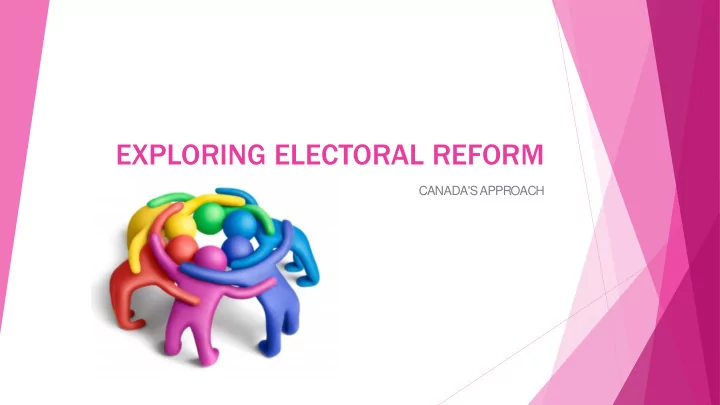

EXPLORING ELECTORAL REFORM CANADA'S APPROACH
ELECTORAL REFORM A change or a review of an electoral system to try to better reflect the will of the public in election results
Thank you for participating in the national dialogue on electoral reform Canadians expect greater inclusion, transparency, meaningful engagement and modernization from their public institutions. Federal electoral reform is part of the Government’s stronger democracy agenda.
Moving Forward Federal electoral reform is part of the Government’s commitment to change. Canada has a strong and deeply rooted democracy. One way to protect our democratic values is by continuously seeking to improve the functioning of our democratic institutions— including our voting system.
Five Guiding Principles for Electoral Reform Rest ore t he effectiveness and legitimacy of vot ing by reducing dist ort ions and st rengt hening t he link bet ween vot er int ent ion and t he elect oral result . Encourage great er engagement and part icipat ion in t he democrat ic process, including inclusion of underrepresent ed groups. S upport accessibility and inclusiveness t o all eligible vot ers, and avoiding undue complexit y in t he vot ing process. S afeguarding t he integrity of our vot ing process. Preserve t he account abilit y of local representation .
S ome Types of Electoral S ystems First-Past-the-Post Ranked Ballot Mixed Member Proportional (MMP)
First-Past-The-Post One member from each riding is The party that forms the government elected by a plurality of the votes is generally the party that is able to see the largest number of its candidates elected in the 338 ridings, Not necessarily a majority/more regardless of its overall share of the than 50 percent of the votes are popular vote in the country required to win A party can win a majority of seats in Winner simply needs to have more the legislature with less than 50 votes than his or her opponent(s) percent of the vote
Ranked Ballot Allows a voter to express relative preferences among candidates. For example, a ranked ballot of A over B over C indicates that the voter prefers candidate A to candidate B, candidate B to candidate C and (thus) candidate A to candidate C.
Mixed Member Proportional It is a proportional system, which means that the proportion of votes a party gets will largely reflect the number of seats it has in parliament. Each voter gets two votes. The first vote is for the political party the voter chooses. This is called the party vote and largely decides the total number of seats each political party gets in Parliament. The second vote is to choose the MP the voter wants to represent the electorate they live in. This is called the electorate vote. The candidate who gets the most votes wins. They do not have to get more than half the votes.
S tay Connected c anada.c a/ de moc r ac y @CdnDe moc r ac y http:/ / www.par l.gc .c a/ Committe e s/ e n/ E RRE #E RRE #Q
Recommend
More recommend